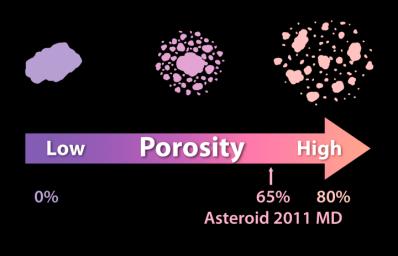
|
Solid as a Rock? Porosity of Asteroids
- Click the image above for a larger view
- Full-Res JPEG (2800 x 1800) (196.5 kB)
- Full-Res TIFF (2800 x 1800) (15.1 MB)
Caption:
Asteroids can differ in the degree of porosity, or the amount of empty space that makes up their structures. At one end of the spectrum is a single solid rock and, at the other end, is a pile of rubble held together by gravity. Observations from NASA's Spitzer Space Telescope, taken in infrared light, have helped to reveal that a small asteroid called 2011 MD is made-up of two-thirds empty space, which means it has essentially the same density as water.
Background Info:
NASA's Jet Propulsion Laboratory, Pasadena, Calif., manages the Spitzer Space Telescope mission for NASA's Science Mission Directorate, Washington. Science operations are conducted at the Spitzer Science Center at the California Institute of Technology in Pasadena. Spacecraft operations are based at Lockheed Martin Space Systems Company, Littleton, Colorado. Data are archived at the Infrared Science Archive housed at the Infrared Processing and Analysis Center at Caltech. Caltech manages JPL for NASA.
For more information about Spitzer, visit http://spitzer.caltech.edu and http://www.nasa.gov/spitzer .
Cataloging Keywords:
| Name | Value | Additional Values |
|---|---|---|
| Target | 2011 MD | |
| System | ||
| Target Type | Asteroid | |
| Mission | Spitzer Space Telescope | |
| Instrument Host | Spitzer Space Telescope | |
| Host Type | Space Telescope | |
| Instrument | ||
| Detector | ||
| Extra Keywords | Color, Infrared, Water | |
| Acquisition Date | ||
| Release Date | 2014-06-19 | |
| Date in Caption | ||
| Image Credit | NASA/JPL-Caltech | |
| Source | photojournal.jpl.nasa.gov/catalog/PIA18455 | |
| Identifier | PIA18455 | |
